Table top dishwasher purchasing advice: how to choose the right product
- What You Need to Know
- Table dishwashers save you having to wash dirty dishes by hand.
- Table dishwashers impress with their clever combination of space-saving design, easy handling and good performance.
- Although there is little space in the small dishwasher, this makes it ideal for single households or the hobby bar in the basement.
- The demands on the tabletop dishwasher are high: it not only has to fit into small kitchens, but also deliver a convincing washing performance. When comparing appliances, size is not the only decisive factor.
Space-saving and energy-efficient – the tableware dishwasher
No more plates for breakfast and the last cup is dirty too? Then the first thing to do is wash up! But this unloved household task can also be avoided: With the table dishwasher, the name says it all. It fits on any table and can be accommodated even in the smallest kitchen. The only prerequisite: some free space on the worktop. Many tabletop dishwashers are hardly any different in size from a microwave oven, i.e. they are about 43 to 52 centimetres high, about 55 centimetres wide and between 43 and 60 centimetres deep. The greater depth distinguishes tabletop dishwashers from microwaves, but this means that quite a lot of dishes can be stored in the appliance on just one level.
What are the advantages of a tabletop dishwasher?
Reduced to one sentence: A tabletop dishwasher is a small-sized dishwasher for use in small kitchens or single households. The appliances have numerous advantages and disadvantages. One big plus is definitely the space-saving design. Of course, this also means that only a limited amount of dishes fit inside. Pots or pans usually still have to be washed by hand. However, many manufacturers advertise that there is room for up to 6 place settings in the tabletop dishwasher.
Compared to a conventional dishwasher, there is less space, as expected, but in terms of cleaning performance, the compact tabletop dishwashers can certainly compete with the larger appliances. Although the power and water consumption is somewhat higher, the comparatively lower purchase price again speaks in favour of the small appliances.
Pro points
- Space-saving design
- Reliable dishwashing
- Manageable purchase costs
Drawbacks
- Usually no space for pots or pans
- Relatively high electricity and water consumption
How does a tabletop dishwasher work?
In terms of operation, tabletop dishwashers are very similar to conventional dishwashers. First, you place the dishes in the drawers, close the door and select the cleaning programme. After starting, the appliance first pumps out any residual water and then starts the actual cleaning process. Depending on the programme selected, the dishwasher will pump water into the appliance several times. The water temperature is between about 40 and 70 degrees Celsius, depending on the selected cleaning programme. After starting, the appliance first heats water to the desired temperature and then distributes it over the dirty dishes via a rotating spray arm, usually from below.
The appliances are never completely filled with water during cleaning. Nevertheless, there are various models with a so-called AquaStop function. This sounds an alarm or interrupts the cleaning process if there is a functional problem with the pump. Higher-quality tableware players, for example from Siemens or Bosch, have so-called load sensors that allow for a more individual dosage of water and detergent.
Drying after cleaning is done by a heating element at the bottom of the dishwasher. It heats the air in the appliance and thus removes the remaining moisture in the interior. Some appliances offer the option of dispensing with drying. This saves energy, but requires subsequent drying by hand. Other features of some tabletop dishwashers include a display of the remaining running time or preselection of the start time. Refill indicators for rinse aid or salt, however, are now standard, as they are in large dishwashers.
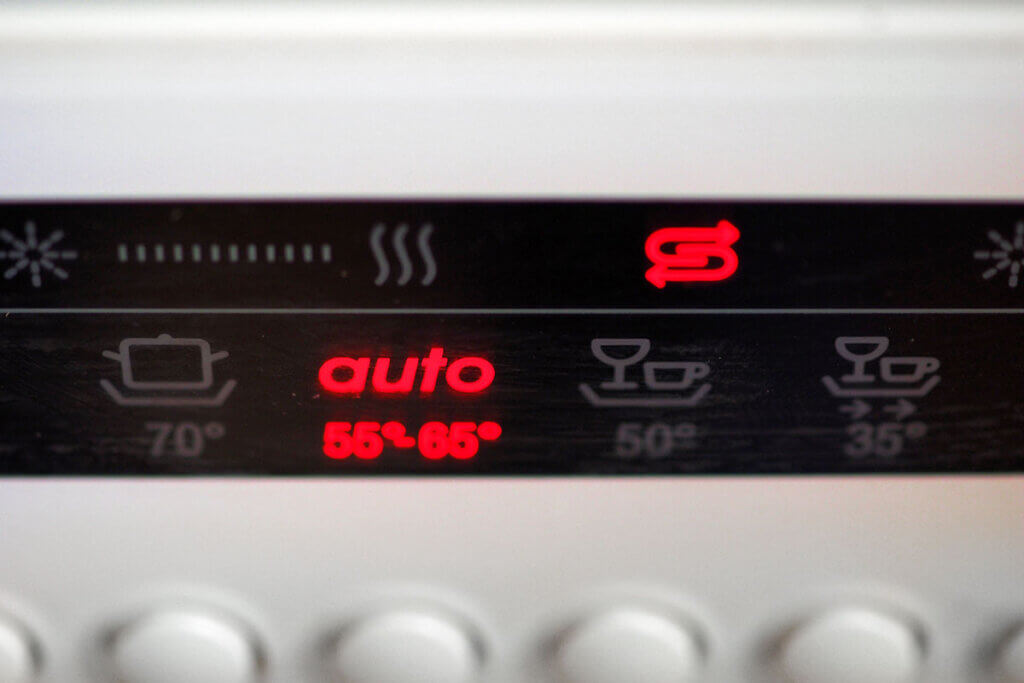
The difference between tabletop dishwashers and dishwashers
Probably the biggest difference between a tabletop dishwasher and a conventional dishwasher is the much more compact design. A normal dishwasher has a width of either 45 centimetres or 60 centimetres. These are two standard dimensions that can be used to integrate the dishwasher into an existing kitchen or to take it into account when planning a new kitchen. The most common models are those with a width of 60 centimetres. However, dishwashers with a width of 45 centimetres have been developed to give smaller kitchens the option of a dishwasher.
For some kitchens, however, even this narrow model is too large. In this case, the tabletop dishwasher is a good alternative. It is only slightly larger than a standard microwave and therefore always finds a place – whether on the worktop or in a small cupboard. Especially for people with health problems, the position on the worktop can be a real bonus of the compact tabletop dishwasher: strenuous bending is no longer necessary.
How much space is there in the compact tabletop dishwasher?
Commercially available dishwashers are designed for about 120 items. This includes larger items such as pots and pans. On average, a tabletop dishwasher can hold about 66 pieces of crockery and cutlery. There is usually no room for larger items. It is true that the cutlery basket can be removed from some appliances, which sometimes provides enough space, at least for no pots. However, you still have to wash the remaining cookware by hand.
In terms of electricity and water consumption, tabletop dishwashers are less efficient than standard-size appliances. The costs can be significantly higher, especially with frequent use. In such cases, models with load or soiling sensors are interesting, as they adapt the cleaning process to the amount of dishes and their soiling. An automatic water dispenser also has a positive effect on the energy efficiency of compact dishwashers.
Advantages of tabletop dishwashers
- Compact design fits even in very small kitchens
- Hygienic dishwashing
- Optional load & soiling sensors as well as automatic water control for more efficient cleaning
Advantages of standard dishwashers
- Very energy efficient
- Holds up to 120 items, including larger items such as pots and pans
- High cleaning performance
Different types of table dishwashers
The requirements placed on compact tabletop dishwashers can be completely different. To meet them nevertheless, the various manufacturers have developed different model types: freestanding, partially integrated and fully integrated tabletop dishwashers.
The freestanding dishwasher
The most common design is the freestanding tabletop dishwasher. It can be placed anywhere there is sufficient space and a power and water connection. As the appliances are always easy to see due to their orientation, manufacturers have placed a lot of emphasis on an attractive design.
Pro points
- Quick and easy to connect
- Many attractive designs
- Individual placement
- Manageable acquisition costs
Drawbacks
- Cannot be integrated into every fitted kitchen
- Visible at first glance
- Loud
The fully integrated dishwasher
The fully integrated tabletop dishwasher is the exact opposite of the freestanding model. The fully integrated version disappears completely into the cupboard and is not externally recognisable as a dishwasher. As with the standard appliance, the door is concealed in the design of the kitchen cabinets so that the overall appearance of the kitchen is not interrupted. Operating elements are concealed in the flap.
Pro points
- Unchanged overall appearance of the kitchen
- Can be integrated into the rest of the furnishings
- Very quiet thanks to insulation
- Control panel not visible
Drawbacks
- Size requires close inspection
- Control panel not easily accessible
- Higher installation costs
- Higher purchase costs
The semi-integrated dishwasher
The semi-integrated dishwasher is a mixture of the two types mentioned above. The tabletop dishwasher is integrated into the built-in cabinets of the kitchen unit, but the front of the appliance remains visible.
Pro points
- Simple operation
- Blends in visually with the kitchen fronts
- Space-saving and compact
Drawbacks
- Dishwasher recognisable at first glance
- No stylish design
- Loud in operation
Which model is right for whom?
Dishwasher requirements are many and varied. However, the three types presented offer numerous individual advantages that suit one user group or another. A fully integrated tabletop dishwasher, for example, is ideal for single households. The kitchen is often rather small, but everything should fit together as well as possible and also look good. In addition, the amount of dishes produced every day is comparatively small, so a standard dishwasher either runs only partially loaded or the dishes have to be collected over in it. The fully integrated tabletop dishwasher is the sensible alternative here. It makes optimum use of the available space and can be used efficiently.
The partially integrated dishwasher is ideal for an office. Here, too, the furnishings should be as stylish as possible, but also efficient. In addition, there are often a lot of people in the office, each of whom wants to drink a coffee or eat something. To prevent dishes from piling up in the kitchen, the compact dishwasher can help. It can also be quickly switched on in between meals, guaranteeing a clean cup for the next coffee at any time. Partially integrated dishwashers also often offer useful extras such as a display of the remaining time or the current process in the course of the cleaning programme. Thanks to the combination of elegant design and kitchen front, they also fit ideally into any interior.
The freestanding tabletop dishwashers are particularly flexible. This makes them suitable for somewhat unconventional uses. They can be set up anywhere and at any time. All that is needed is a power connection and a water connection. For example, they are a good addition to the bar at home or offer pleasant time savings on the next trip with the camper van.
What you should look for when buying
The market for tabletop dishwashers is diverse. There are various models from different manufacturers, to name just a few examples. To find the right model for you, you should consider a few points when making your choice. These include the dimensions, the capacity, the energy efficiency class and the water consumption. But you should also consider the rinsing programmes, the water temperature, an AquaStop function and other features.
Well-known brands: Klarstein | Exquisit | Bomann | Amazonia | MEDION | Bosch | Siemens
Dishwasher dimensions
The available space always comes first. Therefore, measure exactly how much space you have available for installing the dishwasher. A tabletop dishwasher usually has a depth of about 50 centimetres, is about 45 centimetres high and 55 centimetres wide. In addition, there should be enough space behind the appliance for the water connection. Once you have measured the available space, you will have a precise idea of the dimensions of the dishwasher you are looking for and may be able to rule out some appliances from the outset.
Capacity
The second important point is the capacity of the tabletop dishwasher. This is specified by the manufacturer in what are known as measured place settings, in order to obtain a uniform and thus comparable size. One place setting consists of the following eleven items that can be washed in one cycle:
- Shallow plate of 26 centimetres diameter
- Deep soup plate with a diameter of 23 centimetres
- Dessert plate 19 centimetres in diameter
- Small saucer 14 centimetres in diameter
- Glass with a capacity of 250 millilitres
- Cup with a capacity of 200 millilitres
- One knife
- One fork
- One soup spoon
- One cake fork
- One teaspoon
The nominal capacity of a tabletop dishwasher of 6 place settings therefore corresponds to a total of 66 different items. Larger items such as pots or pans, however, are not part of the dishwasher’s capacity and therefore do not make it into the rinse cycle, so they have to be washed by hand.
Washing programmes
The number of wash programmes in a tabletop dishwasher is not decisive. What is more interesting, however, is which programmes are available and which of them are ultimately convincing in terms of washing results. Many dishwashers, for example, have an Eco programme, which has a long running time but can score points with lower electricity and water consumption. If the dishes are more heavily soiled, an intensive programme is needed, which also removes the heavier soiling. Consumption is then naturally higher.
However, the programmes of a tabletop dishwasher are particularly efficient in comparison, as they adjust the water consumption and its temperature as well as the running time to the load and the degree of soiling of the dishes.
Energy efficiency class
The energy efficiency class should generally be taken into account for every electrical appliance. Most new appliances have an efficiency class of A+, which is the minimum standard for dishwashers set by the European Union. On average, table dishwashers consume about 174 kilowatt hours of electricity per year.
Average water consumption
In addition to electricity consumption, you should of course also consider the water consumption of the tabletop dishwasher. Depending on the model, this varies between about 6.5 litres and 8 litres per wash cycle. This means that tabletop dishwashers consume significantly more water than many standard dishwashers. However, with the help of load sensors and sensors to detect the degree of soiling, better consumption values can be achieved here.
AquaStop function
This function is useful for every dishwasher, whether tabletop or standard. If the pump is not working properly or there is a leak in the appliance, the function stops the cleaning process. This prevents flooding and major damage to the appliance.
Rinse temperature
The rinse temperature for most appliances is between about 40 and 70 degrees Celsius, depending on the rinse programme selected.
Features
Some dishwashers come with additional functions or other features. These can include an attractive LED display or useful additions such as the optional start-time preselection, a child lock or the load sensors mentioned above. Consider in advance which functions are important to you and which may not necessarily need to be present.
Connecting the tabletop dishwasher
There are two options for connecting the compact dishwasher: temporarily directly to the tap or long-term via the water installation.
To temporarily connect the table dishwasher to the water tap, proceed as follows: First unscrew the old aerator of the tap and replace it with the model supplied with the dishwasher. Hook the drain hose to the sink and connect the dishwasher’s water connection to the tap: done.
If you are interested in a long-term connection after all, insert a suitable Y-pipe in front of the siphon of the drain. Now turn off the main water tap and replace the stop valve with a double valve. The dishwasher’s inlet hose is now connected to the free water connection. The drain hose is connected to the free connection in front of the siphon. Now the appliance only needs to be plugged in and it is ready for the first washing cycles.
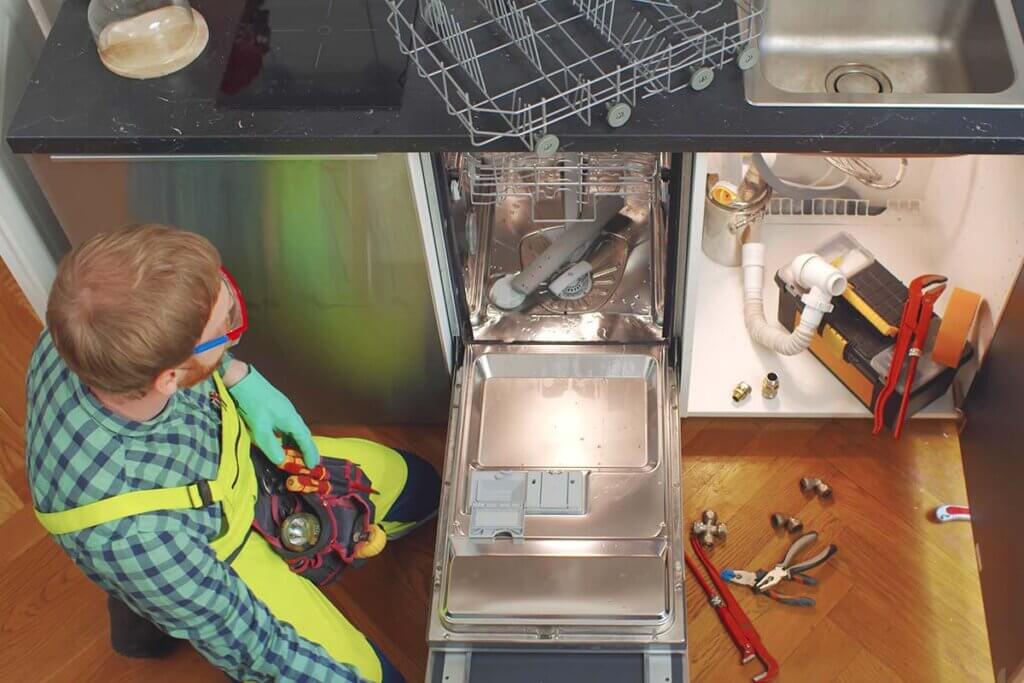

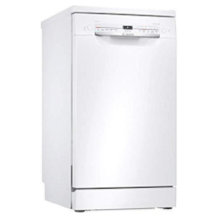
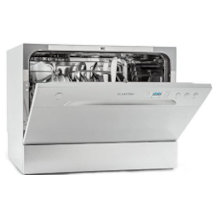
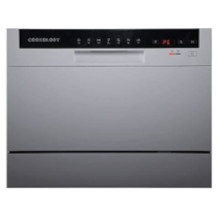
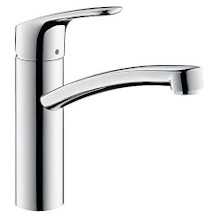
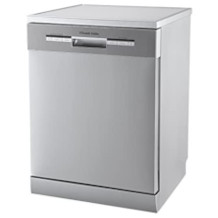
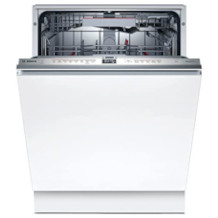
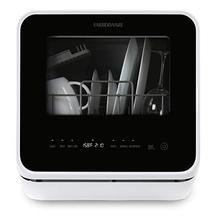
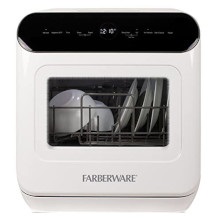
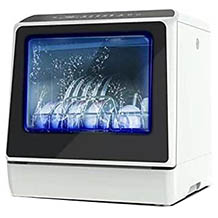

 2,975 reviews
2,975 reviews